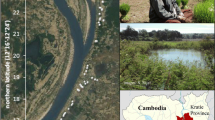Abstract
We examine the decision to plant trees and level of tree planting for two sites, public microdam areas and household agricultural land, and two species groups in Tigray, Ethiopia. Both sites are not perfect substitutes, as they vary with respect to distance from the household and tenure security. The role of permanent pooled water irrigation microdams to tree planting is important but unknown, because water borne diseases, which may influence household income and productivity, are thought to be enhanced by the dams. We find both disease and microdams to be important predictors to tree planting. Disease seems more important in determining whether households plant at all, and less important in the level of planting for those that do plant. For example, disease increases the probability of planting both eucalyptus and other species groups on household-own land, but households suffering from malaria plant higher-cost eucalyptus trees with lower probability at both sites, while planting of other lower-cost species increases at dam sites where other villagers can monitor the trees. We also establish a connection between planting and agricultural residues, finding a strong substitution effect on own-land. Microdam access and age are also important. Households living nearer to dam sites will plant both species groups there with higher probabilities, but the decision to plant on agricultural own-land is not affected. For older dams with more developed irrigation, households are more likely to grow crops rather than plant trees on their own land, but they plant more trees at the dam sites.
Similar content being viewed by others
References
Amacher G.S., Hyde W. and Kanel K. 1999. Nepali Fuelwood Production and Consumption: Regional and household distinctions, substitution, and successful intervention. J. Dev. Stud. 35 (4): 138–163.
Amacher G.S., Hyde W. and Kanel K. 1996. Household fuelwood demand and supply in Nepal: choice between cash outlays and labor opportunity. World Dev. 24 (11): 1725–1736.
Amacher G.S., Hyde W. and Joshee B. 1993a. Joint production and consumption in traditional households: Fuelwood and crop residues in two districts of Nepal. J. Dev. Stud. 30 (1): 206–225.
Amacher G.S., Hyde W. and Rafik M. 1993b. Local adoption of new forestry technologies: An example from Pakistan's Northwest Frontier Province. World Dev. 21 (3): 445–453.
Amemiya T. 1984. Advanced Econometrics. Harvard University Press, Cambridge, UK.
Ahlback A.J. 1995. Mobilizing Rural People in Tanzania to Tree Planting: Why and How. Ambio. 24: 304–310.
Caviglia J.L. and Kahn J. 2000. Diffusion of Sustainable Agriculture in the Brazilian Tropical Rain Forest: A Discrete Choice Analysis. Econom. Dev. Cult. Change 49: 311–333.
Dewees P. 1992. Trees on farms in Malawi: private investment, public policy and farmer choice. World Dev. (23) 2: 1085–1102.
Eicher C.K. 1994. Building productive national and international agricultural research systems. In: Ruttan V.W. (ed.), Agriculture, environment, and health: Sustainable development in the 21st century. University of Minnesota Press, Minneapolis, USA.
Hurni H. 1993. Land degradation, famines and resource scenarios in Ethiopia. In: Pimental D. (ed.), World Soil Erosion and Conservation, pp. 27–62. Cambridge University Press, Cambridge, UK.
Hyde W., Kohlin G., and Amacher G.S. 2000. Social forestry reconsidered. Chapter 12. In: Hyde W. and Amacher G.S. (eds), Economics of forestry and rural development: an empirical introduction from Asia. University of Michigan Press, Ann Arbor, Michigan, USA, pp. 243–287.
Jacoby H. 1993. Shadow wages and peasant family labor supply: An econometric application to the Peruvian Sierra. Rev. Econom. Stud. 60: 903–921.
Kohlin G. and Parks P. 2001. Spatial variability and disincentives to harvest: deforestation and fuelwood collection in South Asia. Land Econom. 77 (2): 206–218.
Madalla G. 1986. Limited dependent and qualitative variables in econometrics. Econometric Society Monographs #3.
Nibbering J.W. 1999. Tree Planting on Deforested Farmlands, Sew Hills, Java Indonesia: Impact of Economic and Institutional Changes. Agrofor. Syst.. 46: 65–82.
Salam M.A., Noguchi T., and Koike M. 2000. Understanding Why Farmers Plant Trees in the Homestead Agroforestry in Bangladesh. Agrofor. Syst. 50: 77–93.
Singh I., Squire L., and Strauss J. 1986. The basic model: theory, empirical results, and policy conclusions. In: Singh I., Squire L. and Strauss J. (eds), Agricultural household models. Johns Hopkins University Press, Baltimore, Maryland, USA, pp. 39–69.
Thornton J. 1994. Estimating the choice behavior of self-employed business proprietors: an application to dairy farming. Southern Econom. J. 87 (4): 579–95.
Varian H. 1986. Microeconomic Analysis. Norton Press, New York, New York, USA.
Author information
Authors and Affiliations
Corresponding author
Rights and permissions
About this article
Cite this article
Amacher, G.S., Ersado, L., Hyde, W.F. et al. Tree planting in Tigray, Ethiopia: the importance of human disease and water microdams. Agroforestry Systems 60, 211–225 (2004). https://doi.org/10.1023/B:AGFO.0000024411.22604.0a
Issue Date:
DOI: https://doi.org/10.1023/B:AGFO.0000024411.22604.0a




